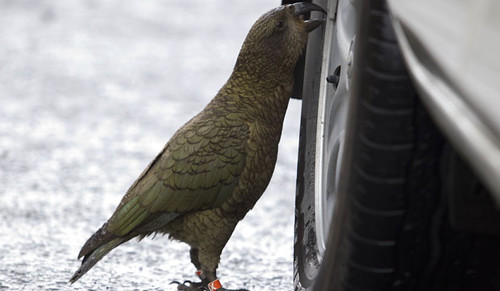Spray-on repellent could outwit incorrigible kea
 Thursday, September 20, 2012 at 11:15
Thursday, September 20, 2012 at 11:15  OPTIMIST: An Otira Gorge kea tries a tyre out for size.Kea are renowned for their curiosity but can clash with humans, as anyone who has had rubber stripped from their cars at southern skifields can attest.
OPTIMIST: An Otira Gorge kea tries a tyre out for size.Kea are renowned for their curiosity but can clash with humans, as anyone who has had rubber stripped from their cars at southern skifields can attest.
But the Kea Conservation Trust is developing repellents to stop the endangered parrots in their tracks.
Its efforts attracted praise last week at the West Coast Conservation Awards.
Trust chairwoman Tamsin Orr-Walker said the move was prompted by an urgent need to protect kea from aerial drops of 1080, which caused high death rates, particularly on the West Coast.
Initial trials of a non-toxic bird repellent in bait have proved successful on captive kea.
It worked by making them feel sick when they ate repellent-laced bait so they learnt to avoid trying it again, she said.
Studies are under way to ensure the repellent does not deter rats and possums from eating 1080 bait.
 IAIN MCGREGOR/Fairfax NZ KEA HAS LANDED: Ashaa Hsieh watches a kea perched on her car.The trust is also investigating surface repellents to stop other problem kea habits, such as attacking sheep to peck the fat around their kidneys, and destroying equipment, such as kill traps or bait stations, foiling efforts to kill introduced predators.
IAIN MCGREGOR/Fairfax NZ KEA HAS LANDED: Ashaa Hsieh watches a kea perched on her car.The trust is also investigating surface repellents to stop other problem kea habits, such as attacking sheep to peck the fat around their kidneys, and destroying equipment, such as kill traps or bait stations, foiling efforts to kill introduced predators.
The first trial of surface repellent, which is released when a kea lands on it, was done on a Queenstown farmer's merino sheep in June.
It makes kea feel sick if it lands on the animal then later preens, swallowing some repellent from its contact.
Orr-Walker said initial results suggested it worked but further studies would start next week.
Orr-Walker hoped that by next year's ski season, spray-on kea protection for cars and outside equipment might be a reality.
Porters Ski Area marketing manager Guy Nurse applauded the trust's initiative and said he believed it would prove a winner.
 Nestor notabilis - Kea | in
Nestor notabilis - Kea | in  Conflict,
Conflict,  Conservation,
Conservation,  Research,
Research,  Training
Training 
